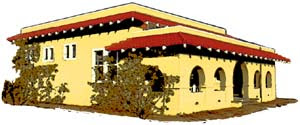A view of Route 66 in Arizona, circa 1960. HULTON ARCHIVE/GETTY IMAGES
Associated Press
Tens of thousands of people visit the Arizona Route 66 Museum each year, aiming to get a feel for what it was like to take the old highway route that crossed eight states to connect Chicago to the West Coast.
Visitors to the Kingman museum spend hours looking at displays, photographs and life-size dioramas of the groups and events that depict the evolution of the highway that came to fame in the mid-20th century, the Kingman Daily Miner reported.
In his four years volunteering with the museum, T.R. Srigley said he sees just as many foreign tourists as Americans. The diverse appeal of the museum is evidenced by shelves of brochures, which describes the more than 20 exhibits in six different languages.
"It seems to me like a lot of people are from China and Europe. There's an awful lot of them," Srigley said. "They know a lot about Route 66; it's pretty amazing. They know more about Route 66 than the Great Wall of China."
Visitors can see a 1950 Studebaker Champion, originally priced at $1,487. Another exhibit features a rusty old Ford truck loaded with pots and pans, furniture and other worldly belongings of an Oklahoma family fleeing the Dust Bowl, emblematic of the Joad family in John Steinbeck's "The Grapes of Wrath."
The museum, operated by the Mohave Pioneers Historical Society, opened in 2001 and draws about 50,000 visitors each year.
"This really is the museum that helps explain the significance of Route 66 to our culture through the ages," said Josh Noble, Kingman's director of tourism.
The museum is located in the former Kingman Powerhouse, which once lighted the way for early Route 66 travelers, said Shannon Rossiter, director of the Mohave Museum of History and Arts.
The historic building was constructed between 1907 and 1911 to produce power for mines. The facility was mothballed following the construction of the Hoover Dam. It was restored and reopened as a visitors' center in 1997.
Sunday, May 6, 2018
Subscribe to:
Posts (Atom)




